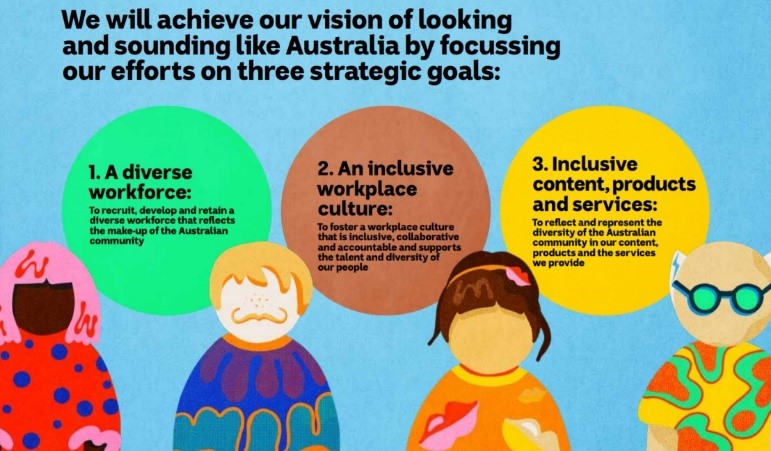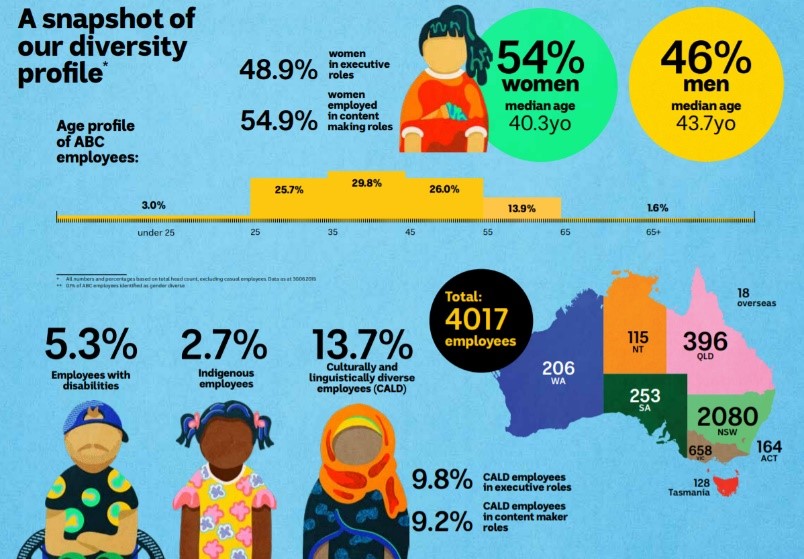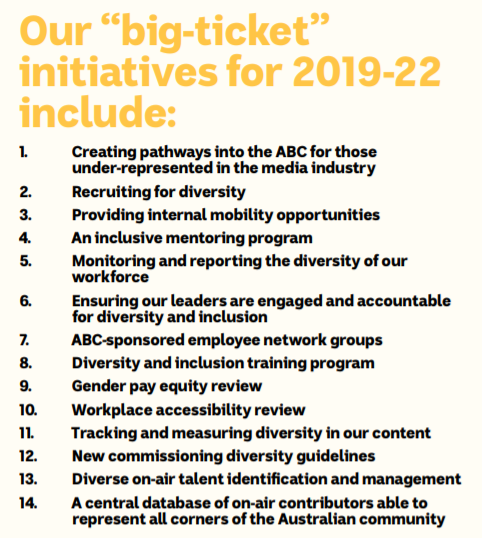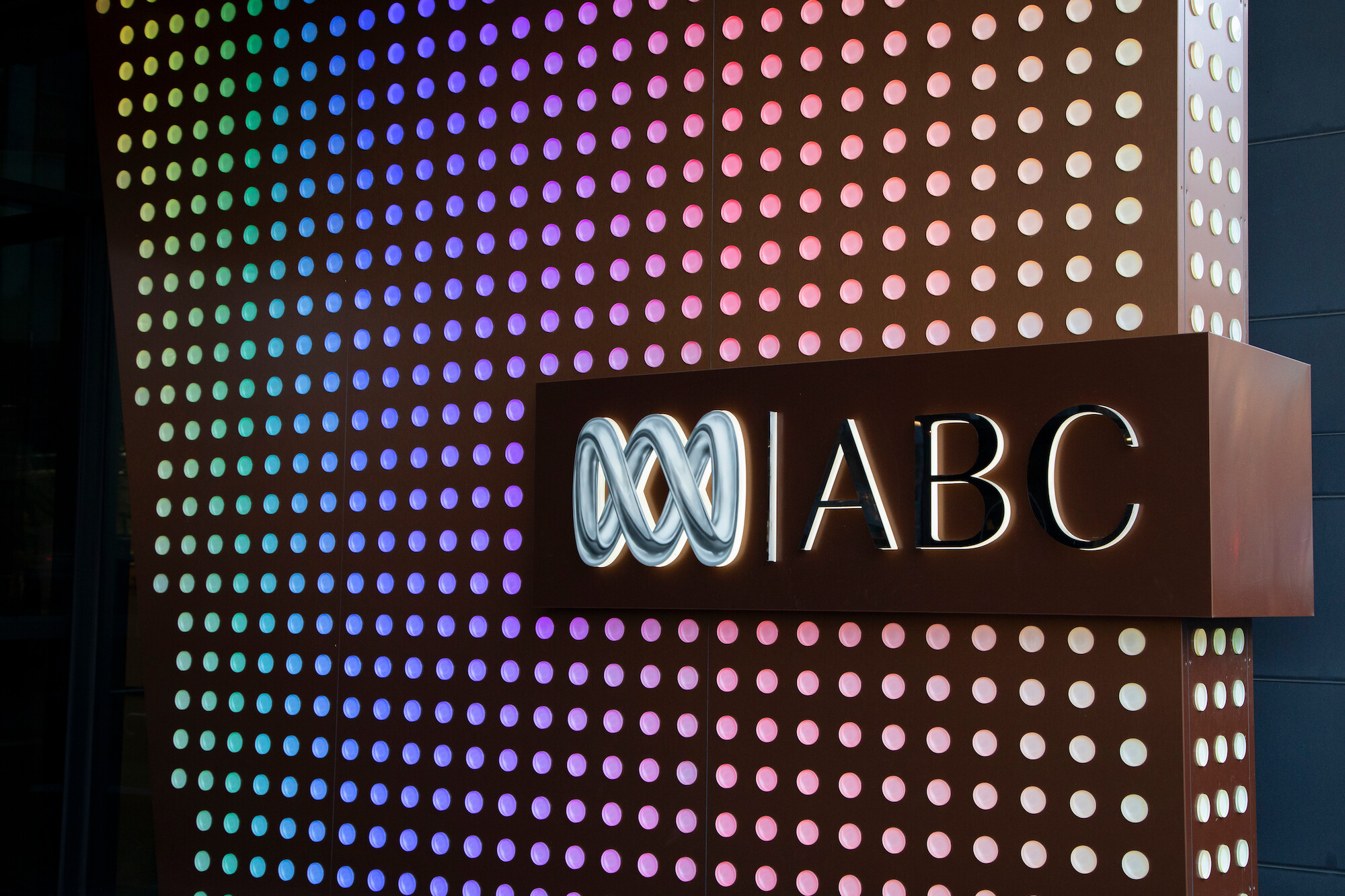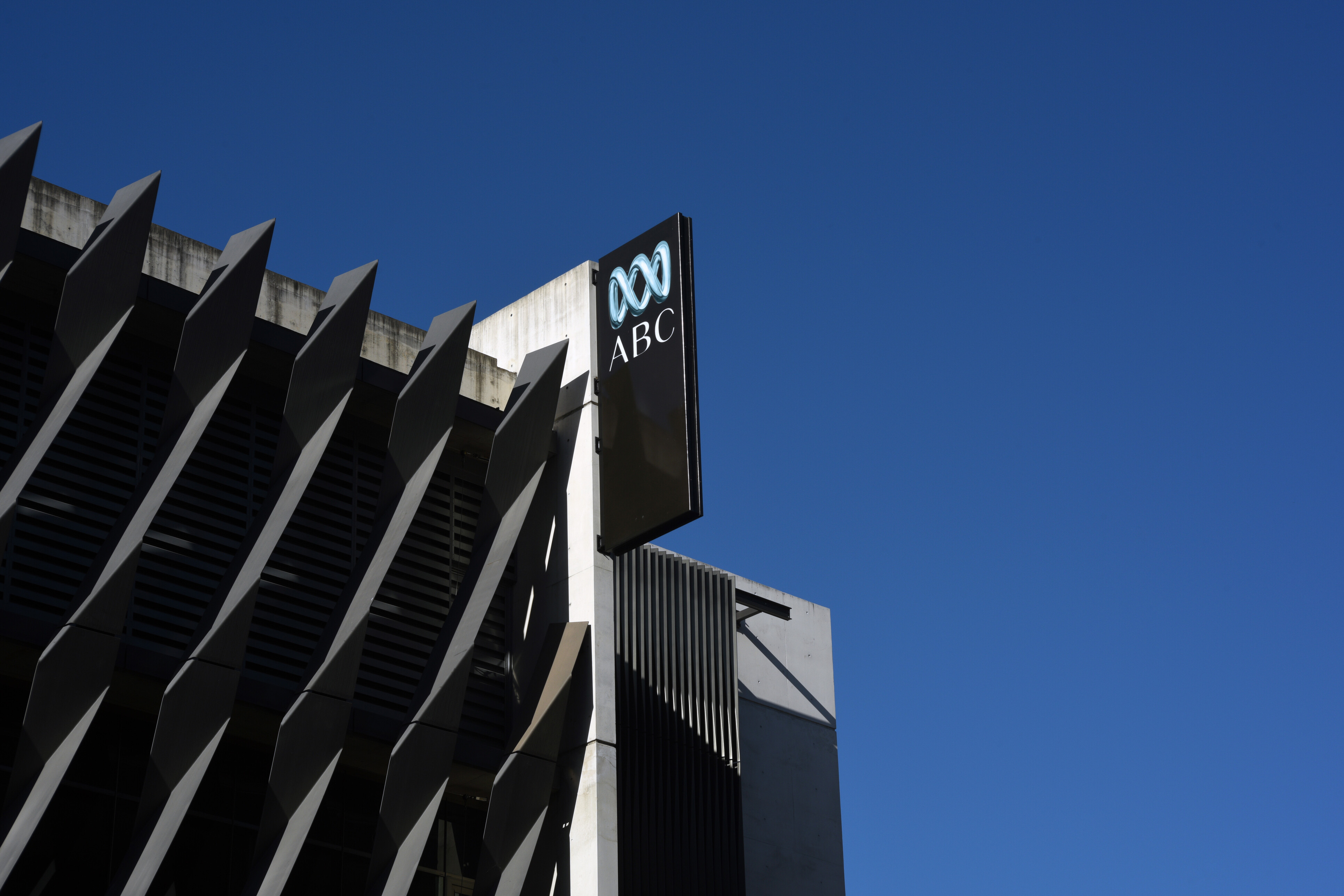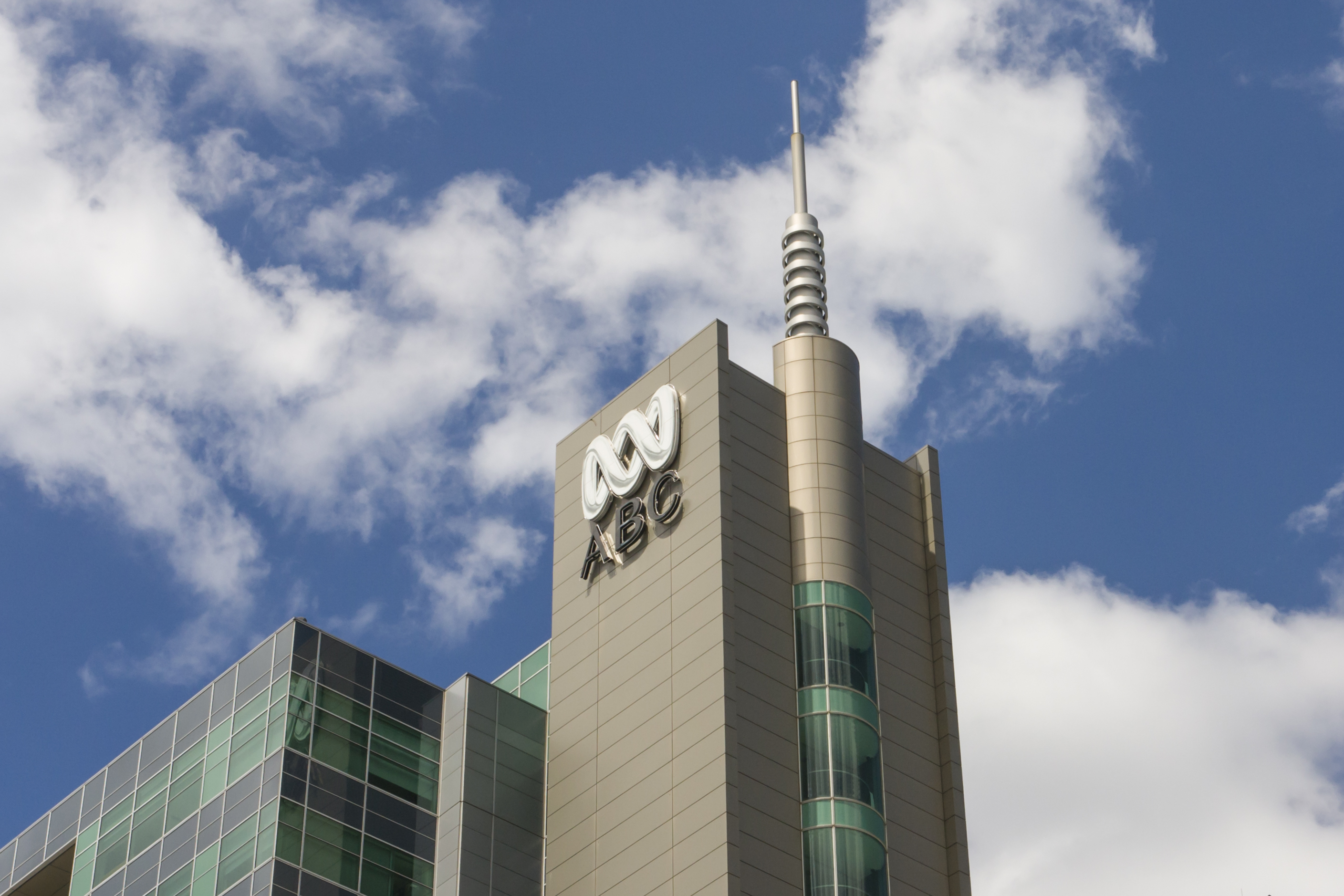Effective public media should be accountable to the breadth of society. For the Australian Broadcasting Corporation this means placing diversity, equity, and inclusion centre stage.
By Desilon Daniels
Australian public broadcaster SBS is highly regarded for its diversity and inclusion initiatives, such as its provision of content in over 60 languages. But what of the country’s largest public broadcaster, the Australian Broadcasting Corporation (ABC)?
The ABC is fast building a reputation for diversity, equity, and inclusion. In keeping with legislative requirements to promote equal opportunities for women, Aboriginal and Torres Strait Islander people, those from a non-English speaking background, and people with disabilities, the corporation has crafted a series of diversity plans over the years.
Most recently, the public broadcaster revealed it had hit a diversity milestone in March when its news division, ABC News, met the 50:50 Challenge to achieve equal representation of male and female commentators and interviewees in its news coverage. The challenge is a component of a BBC project, which encourages local and international media organisations to accurately represent the gender balance of the publics they serve.
ABC’s recent success is part of a bigger picture: the broadcaster is just over a year into its Diversity and Inclusion Plan 2019-22, which covers the period 1 September 2019 to 31 August 2022. However, the plan’s execution has met some unavoidable challenges.
PMA spoke with Cinda Viranna, ABC’s Head of Indigenous, Diversity & Inclusion, to discuss what diversity means to ABC, and how the corporation’s diversity plans are standing up amid the COVID-19 pandemic, the global Black Lives Matter protests, budget cuts, and criticisms from the public.
Why Diversity & Inclusion matters
For ABC, “diversity” refers to both visible and invisible differences among people. Viranna said that while visible differences can be gender, language, ethnicity, age, and cultural background, invisible differences can include religious belief, sexual orientation, and certain disabilities.
While some aspects of diversity, such as age or language, are easier to pinpoint than others, ABC has a comprehensive data collection process to ensure that all target markers are covered. Viranna explained that staff are asked on a voluntary basis to provide information about markers such as their age, gender, cultural diversity, visible or invisible disability, sexual orientation, caring status, and being Aboriginal or Torres Strait Islander. “This is in addition to questions about their location, as we have a number of regional and city locations across Australia,” Viranna added.
Meanwhile, inclusion for ABC means “embracing diversity and fostering a culture that values people’s unique backgrounds, experiences, and perspectives”. Viranna said, “Inclusion in our teams is about our people’s individual experience and the extent to which they feel respected and valued. It means creating a supportive environment in which our people feel safe to be themselves and inspired to contribute to the ABC’s vision.”
These two concepts are the backbone of ABC’s Diversity & Inclusion Plan. The development process occurred at several levels, with a review of all previous plans, extensive consultation with ABC Divisions and its diversity champions, as well as with external industry partners and specialist organisations.
ABC is required by legislation to design an Equal Employment Opportunity (EEO) programme to not only eliminate discrimination but also promote equal opportunity. Over the years, ABC has produced several plans. But achieving diversity and inclusion goes beyond legislative requirements. Viranna explained to PMA that, as a public broadcaster, representing its audience is a part of ABC’s DNA.
“Representing diversity in our workforce, content and services means something to the ABC. We’re the national broadcaster and it’s baked into our Charter that we need to reflect the nation, foster a sense of national identity and reflect the cultural diversity of the nation,” she said.
“The ABC’s vision is to be the home of all Australians’ stories and to fulfil that we must embrace diversity. It also makes our journalism and stories richer and better. We know that making sure we look and sound like contemporary Australia is crucial to our ongoing relevance – if we don’t reflect and engage with our audience we will be less and less relevant to the Australian people.”
Challenges and criticisms
The current Diversity & Inclusion Plan was developed to continue with successes and overcome unmet targets. ABC has made good progress: by the end of August 2019, ABC had a gender-balanced workforce and leadership, had increased the representation of Aboriginal and Torres Strait Island People in its workforce, and had met its disability target. The 2019-22 Plan was developed as a three-year strategic roadmap “to guide the ABC in further developing its diverse, inclusive culture, with a workforce profile, content offering and services that reflect the diversity of the Australian community”.
But this roadmap could not foresee a global pandemic just six months down the line.
“While there was still significant progress in many programmes and initiatives, the COVID-19 pandemic did disrupt key aspects of the diversity strategy. For example, non-urgent recruitment was put on hold for a while, impacting the organisation’s ability to recruit for diversity. The Indigenous recruitment strategy was also put on hold. Some content initiatives and staff events had to be delayed or cancelled,” Viranna said.
ABC was also met with the challenge of increased cyberbullying, particularly targeting its diverse groups of staff and talent. In response, the broadcaster created the Cyber Safety Steering Committee to enhance the safety of staff and audiences by monitoring trends and providing guidance.
But even before the onset of the pandemic, ABC faced criticisms for its lack of diversity in on-air talents, especially when it came to its hard-hitting flagship shows and political programmes. Media Diversity Australia’s August 2020 report “Who Gets to Tell Australian Stories” analysed the representation of cultural diversity in Australian television news and current affairs. One key component of the report’s methodology was an examination of 81 Australian news programmes over two weeks in June 2019, covering approximately 19,000 free-to-air television news and current affairs items. When measuring the frequency of appearances on screen, the report found that 75% of presenters, commentators, and reporters were from an Anglo-Celtic background, compared to only 6% with either an Indigenous or non-European background. Compared to Australia’s demographics – where 58% of Australians have an Anglo-Celtic background, 21% have a non-European background, 18% have a European background and 3% have an Indigenous background – cultural diversity in television news and current affairs is not representative of the population.
Public broadcasters, including ABC, had the lowest percentage of Anglo-Celtic presenters, reporters, and commentators. The report notes that while ABC and public broadcaster SBS both have Charters that require them to measure and report cultural diversity, commercial networks do not have the same.
In the same report, ABC’s board was noted as having “overwhelmingly Anglo-Celtic representation”. However, 67% of its board members and 43% of ABC’s news leaders were women.
“ABC News performed well in the report compared to the overall television sector. However, we know we have significant work to do to live up to the goals we have set for ourselves,” Viranna said.
Outlining ABC News’ policies to achieve more diversity milestones, Viranna explained, “ABC News has both workforce and content goals around diversity, which are outlined in the News Diversity Action Plan. That means we’re taking steps to ensure the make-up of our news team is more diverse as well as looking to increase diversity in our stories to better reflect the community.” She also explained that ABC News’ has a staff-led Diversity Advisory Group that is reviewing a range of pilot projects, “including around the use of Indigenous language in our content, the merits of considering diversity issues in our editorial conversations and support and training for diverse staff.” Additionally, ABC News’ “More Relevant to More Australians” editorial strategy emphasises the importance of “being part of more communities” by covering more stories relevant to people in Australia’s most diverse outer suburbs.
She continued, “In terms of content, we’re keen to understand more about who features in our content and the types of stories and discussions they appear in. The aim is to inform our commissioning process and achieve the talent diversity targets set by the ABC’s Diversity & Inclusion strategy by the end of 2022.”
Successes
Despite the challenges and criticism, there is much for ABC to be proud of. In addition to its employee network group, ABC Pride and Bonner Committee – its well-established Indigenous advisory committee – ABC has expanded to include the ABC Belong and ABC Inclusive employee groups, which focus on accessibility and people with disabilities. ABC Belong and ABC Inclusive were launched after the current Diversity and Inclusion plan came into force.
Outside of its participation in the BBC’s 50:50 Project, ABC is also a part of the 50:50 Equality Project News, which tracks the representation of Indigenous and culturally diverse people, along with people with disabilities. For the first time, the broadcaster will also have a position to cover disabilities, filled by a correspondent with lived experience.
“Working in diversity and inclusion can be challenging work so it’s important to celebrate the wins. One of the things that I enjoy most and am most proud of is the work that my team and I do with our employee network groups. They’re powered by a lot of energetic people who want to make our workplace better.”
“It’s been a real privilege to work with our network groups and to see what they have achieved, including ABC Pride marching in Mardi Gras for the first time ever in 2020; the launch of an Elevate Reconciliation Action Plan, which seeks to increasingly put Indigenous languages and stories at the heart of the ABC’s storytelling; and ABC Inclusive organising an ABC-wide content collaboration on International Day of People with Disability that featured stories by people with disability on a range of our platforms,” Viranna said.
By August 2022, ABC’s workforce may look very different. According to its 2019-2022 Plan, the public broadcaster aims to have 50% of all executive roles and 20% of technologist roles filled by women; 15% of executive roles and 15% of content maker roles filled by culturally and linguistically diverse employees; 8% of its employees with disability; and 3.4% Aboriginal or Torres Strait Island/Indigenous employees. ABC also aims to start recording diversity data on gender identity and sexual orientation for the first time, with the possibility of setting a new target for LGBTQI+ representation in its workforce, decided at the Plan’s mid-term review.
ABC has made considerable advances in diversity and inclusion although, as with many public broadcasters, there is still much work to be done. Understandably, the pandemic, along with global conversations on race, equality, and equity which re-emphasised the need for diverse newsrooms, may affect or shift its goals. Further, ABC’s own internal issues, such as its funding challenges, may also have ripple-on effects in its ability to meet its goals. Nonetheless, ABC, as a public broadcaster, must be reflective of the society it serves. ABC must therefore continue to stay the course, continue to keep track and make real and sustainable improvements.
THE DIVERSITY & INCLUSION PLAN AT A GLANCE
Source: ABC Diversity & Inclusion Plan 2019-22
- The ABC Diversity & Inclusion Plan 2019-22 covers a three-year period, from 1 September 2019 to 31 August 2022. It sets out the public broadcaster’s diversity and inclusion vision, along with its strategic goals and steps towards realising the vision.
- the Plan has three strategic goals: 1) to recruit, develop and retain a diverse workforce; 2) to foster a workplace culture that is inclusive, collaborative, and accountable and leverages the talent and diversity of our people; and 3) to reflect and represent the diversity of the Australian community in our content and the services we provide.
- The Plan focuses on five key diversity areas: Aboriginal and Torres Strait Islander people; gender; cultural and linguistic diversity (CALD); disability; and LGBTQI+. However, other diversity markers, such as age, geographic location, and socioeconomic status, are also very important, ABC said.
Header Image: Sydney, Australia – March 24, 2015: People entering and leaving the Australian Broadcasting Corporation (ABC) Centre in Ultimo. Credit: kokkai/iStock
Related Posts
20th May 2021
Focus On ABC: Budget, press freedom and new Board members
From legal battles and funding issues…
17th August 2020
ABC Statement to the Senate Press Freedom Inquiry by Director News, Gaven Morris
"It’s more than three years since the…
